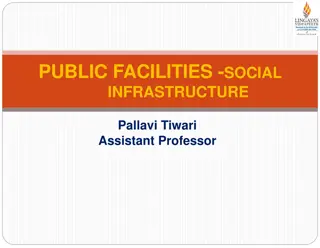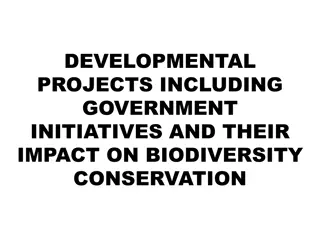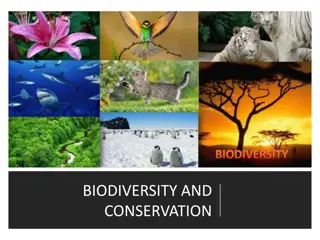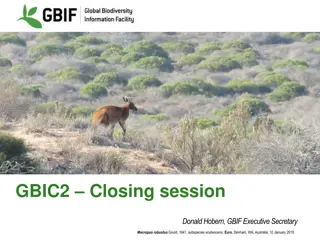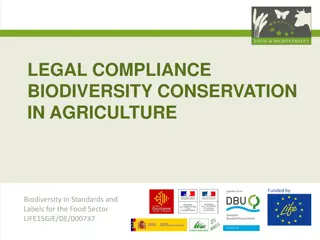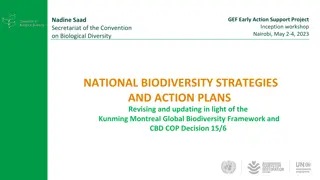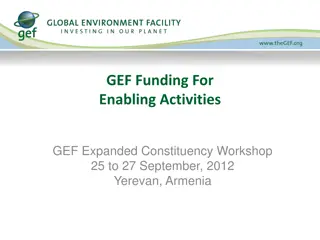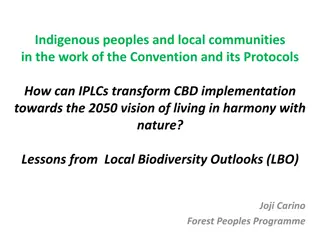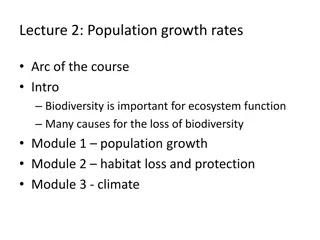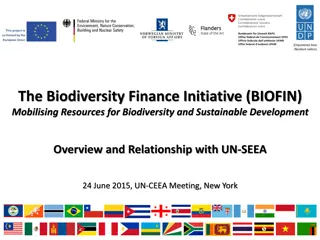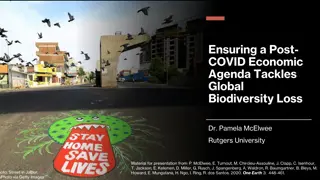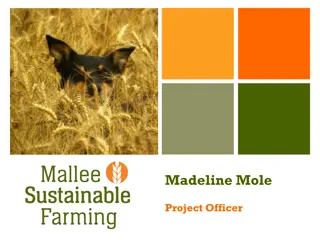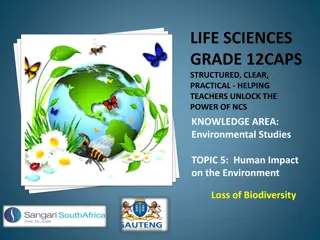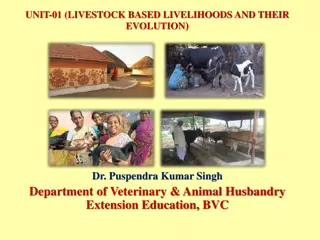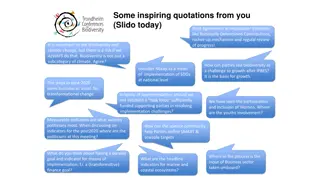Sustainable Farming Practices for Biodiversity Conservation
Implementing no-till and cover crop farming methods, along with surge irrigation, can significantly reduce human impacts on ecosystems, preserve biodiversity, and maintain healthy population dynamics. These practices help prevent soil erosion, nutrient loss, and habitat destruction, promoting sustainable agriculture while supporting native flora and fauna populations.
Uploaded on Sep 22, 2024 | 0 Views
Download Presentation

Please find below an Image/Link to download the presentation.
The content on the website is provided AS IS for your information and personal use only. It may not be sold, licensed, or shared on other websites without obtaining consent from the author.If you encounter any issues during the download, it is possible that the publisher has removed the file from their server.
You are allowed to download the files provided on this website for personal or commercial use, subject to the condition that they are used lawfully. All files are the property of their respective owners.
The content on the website is provided AS IS for your information and personal use only. It may not be sold, licensed, or shared on other websites without obtaining consent from the author.
E N D
Presentation Transcript
BIOLOGY: BIODIVERSITY AND POPULATION DYNAMICS HUMAN IMPACTS ON EARTH S SYSTEMS Diedre Young MAT Soybean Science Challenge Coordinator
NGSS STANDARDS Topic Three: Biodiversity and population dynamics. BI-LS2-6 BI-LS2-7 BI3-ETS1-3 Topic Seven: Human Impacts on Earth s Systems. BI-ESS3-2 BI-ESS3-4 B17-ETS1-1
USING NO TILL AND COVER CROP FARMING PLUS SURGE IRRIGATION Using new designs to decrease changes to the ecosystem and reduce human impact. Standard tilling of land causes soil erosion, water/nutrient loss and destroys the soil ecosystem. This allows for negative changes to the ecology. No till/crop cover farming keeps the biomass on the surface and holes are drilled through this for seed planting. No till /crop cover allows for biomass to become soil, the ecosystem to stay stable and an increase in water/nutrient absorption to occur. No Till Crop Cover for Watermelons
Poly-Pipe and Surge Irrigation Competing solutions to reduce human activities and solve a major global challenge. Regular furrow irrigation involves running lots of water down a channel for hours at a time. This increases water loss by evaporation and increases mineral/chemical loss (plus pollution) through tail water pooling at the end of fields. Poly-pipe directs water in smaller amounts and by surging, more water is absorbed in the roots. Poly Pipe and Surge Irrigation in a field
So how does this affect Biodiversity? Every time soil is tilled, it disrupts the life cycle of all fauna living in this delicate ecosystem. It decreases the productivity of the native plants and animals and allows invasive species to take hold. Nutrients are exposed to the air and lost as dust. Soil erosion and habitat/water loss are global issues, and these are caused by tilling. Cover crops are crops grown in the winter to nurture the soil and to decrease nutrient and water loss. The crops are not harvested, they are meant to stay in the field. By combining no till and cover crop technology, farmers are ensuring that local ecosystems with their biodiversity are preserved, water usage is decreased, and nutrients stay where they belong.
And how does this affect population dynamics? Tilling an area is literally like having a tornado go through your house. You spend time and resources to rebuild only to have that tornado come through again. Flora and fauna in this ecosystem are using valuable resources to rebuild each time a tilling occurs. This also allows invasive pests to take hold because the system is weak. Due to this, populations of native flora and fauna suffer, and farmers are forced to used fertilizers and pesticides to balance. No till /cover crops allow the native flora and fauna to achieve healthy populations and compete against unwanted pests. It also encourages native predators to live in the area. This, in turn, contributes to healthy soil and less chemicals used by farmers.
Human Impacts and Earth Systems Farming the soil has a huge impact on local flora, fauna, soil and water. We need to farm to eat so how do we grow sufficient food (at a decent cost) while protecting the environment? Farmers have turned to research and technology to help grow the food we need all while decreasing the impact on the local ecosystems. Research has shown that no-till and cover crops protect and nurture the soil, keep local flora and fauna healthy and increases water absorption to the roots. This translates into less water, fertilizer and insecticide usage for famers. By using cutting edge research, both farmers and the ecosystem win! By using poly-pipe and surge irrigation, not only is less water used but water is being used more efficiently. This means less water waste, less pollution and healthier plants! This technology that not only helps the ecosystem but saves the farmer money, with this savings being passed on to the consumer.
Check This Out! This video shows how a poly-pipe is holed for irrigation. The diameter of a pipe is dependent on the amount of water needed for that crop and particular soil type.
Learn more about how soil and climate are interrelated! https://www.youtube.com/watch?v=T4A_rMlHcyE


